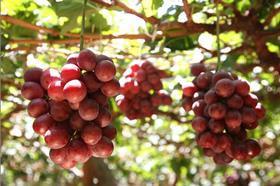
Peruvian grape exporters are reflecting on a stellar 2010/11 campaign that saw global shipments grow by some 40 per cent to 11.3m cartons (8.2kg), up from 8.06m cartons in 2009/10, according to Provid.
Exports to Asia kept pace with that impressive growth rate, rising from 2.17m cartons in 2009/10 to 3.24m cartons. That saw Asia’s market share of Peruvian grape exports hold steady at close to a third of overall sendings.
“Asia is becoming an increasingly important and attractive market for Peruvian table grapes in general,” confirmed Jesica Larovere Frigo of Pedregal, one of Peru’s leading table grape exporters. “The availability of Peruvian grapes is growing and so too are exports to Asia.'
Pedregal is already marketing more than a third of its production in Asia, where it has been working assiduously to develop its Red Dragon label for the past 10 years. In 2010/11, the company shipped more than 600,000 cartons of grapes to Asia, giving it close to a 20 per cent market share of total Peruvian sendings to the region.
Another company targeting Asia very closely is Delica Peru, with the region accounting for the majority of the 300,000 cartons of grapes it exported this year. “With a few exceptions, the Peruvian grape deal has been outstanding this 2010/11 season, with good quality and prices and strong demand from the markets,” said the company’s Nick Fitzpatrick.
Hong Kong/China remains by far the largest market in Asia for Peruvian grapes, with a combined import volume of 1.9m cartons in 2010/11. Indonesia comes second, absorbing around 500,000 cartons, followed by Thailand, Vietnam and Taiwan each taking roughly 100,000 cartons.
Feedback from Asian importers also confirms Peru’s emerging profile in the region. “Peru has really grown to become an important player in the Asian market,” said Jason Bosch of Shanghai-based importer Origin Direct Asia. “Historically they were in the shadows of late US supply and struggled to compete on quality and taste with South Africa and Chile, but over the last three years they have really come into the limelight on Red Globes, producing some top-quality fruit with all the right characteristics for this market.
“I think Peru is really going to grow to become a major player in the market with fairly cheap land and labour and dedication to improvement,” he added.
Exporters also see good grounds to further expand shipments to Asia. “Quality is improving every year as growers gain a better understanding of their land and crop management as well as adjusting to market requirements,” said Mr Fitzpatrick.
Ms Larovere said growth opportunities for Peruvian grapes exist across all the key Asian markets, while cautioning that meeting their specific demands is key. “As growers and exporters, we must pay very close attention to the requirements of every market so as to be able to satisfy their exact needs in respect of volume and quality,” she told Fruitnet.com.
Reflecting the rising importance of Asian markets, Peru has also been stepping up its market access efforts in the region, Mr Larovere added. “Peru has been working to open up markets where we don’t have protocols, such as Japan and Korea, and to reopen other markets, as has been the case with Thailand this 2010/11 season,” she said.
While acknowledging the great potential for further growth in Asia, Mr Fitzpatrick cautioned that Peru must manage that growth well, learning from Chile’s mistakes. “The Chilean `grape` industry grew so fast that they couldn’t sustain returns and profitability,” he said. “It’s now under a lot of pressure with only the best growers being comfortably profitable.”



